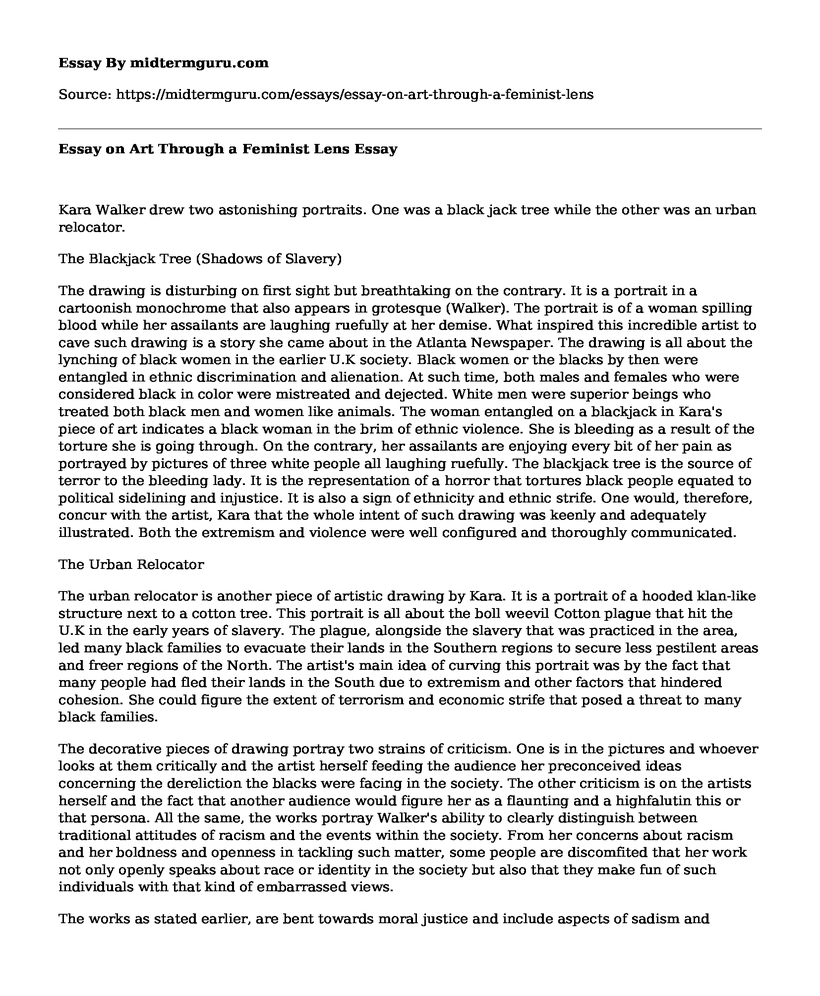Kara Walker drew two astonishing portraits. One was a black jack tree while the other was an urban relocator.
The Blackjack Tree (Shadows of Slavery)
The drawing is disturbing on first sight but breathtaking on the contrary. It is a portrait in a cartoonish monochrome that also appears in grotesque (Walker). The portrait is of a woman spilling blood while her assailants are laughing ruefully at her demise. What inspired this incredible artist to cave such drawing is a story she came about in the Atlanta Newspaper. The drawing is all about the lynching of black women in the earlier U.K society. Black women or the blacks by then were entangled in ethnic discrimination and alienation. At such time, both males and females who were considered black in color were mistreated and dejected. White men were superior beings who treated both black men and women like animals. The woman entangled on a blackjack in Kara's piece of art indicates a black woman in the brim of ethnic violence. She is bleeding as a result of the torture she is going through. On the contrary, her assailants are enjoying every bit of her pain as portrayed by pictures of three white people all laughing ruefully. The blackjack tree is the source of terror to the bleeding lady. It is the representation of a horror that tortures black people equated to political sidelining and injustice. It is also a sign of ethnicity and ethnic strife. One would, therefore, concur with the artist, Kara that the whole intent of such drawing was keenly and adequately illustrated. Both the extremism and violence were well configured and thoroughly communicated.
The Urban Relocator
The urban relocator is another piece of artistic drawing by Kara. It is a portrait of a hooded klan-like structure next to a cotton tree. This portrait is all about the boll weevil Cotton plague that hit the U.K in the early years of slavery. The plague, alongside the slavery that was practiced in the area, led many black families to evacuate their lands in the Southern regions to secure less pestilent areas and freer regions of the North. The artist's main idea of curving this portrait was by the fact that many people had fled their lands in the South due to extremism and other factors that hindered cohesion. She could figure the extent of terrorism and economic strife that posed a threat to many black families.
The decorative pieces of drawing portray two strains of criticism. One is in the pictures and whoever looks at them critically and the artist herself feeding the audience her preconceived ideas concerning the dereliction the blacks were facing in the society. The other criticism is on the artists herself and the fact that another audience would figure her as a flaunting and a highfalutin this or that persona. All the same, the works portray Walker's ability to clearly distinguish between traditional attitudes of racism and the events within the society. From her concerns about racism and her boldness and openness in tackling such matter, some people are discomfited that her work not only openly speaks about race or identity in the society but also that they make fun of such individuals with that kind of embarrassed views.
The works as stated earlier, are bent towards moral justice and include aspects of sadism and barbarism. On the contrary, I wouldn't constitute that Kara's actions are causing revolt and negativity and also a form of betrayal of the slaves particularly for the purpose of amusing and establishing of the white art investment. I would also like to differ with the thoughts of some of her fellow artists that the impressions of her black images are a measure of negativity and her conservative nature. It is not that her presentations involving versions of black portraits are pandering or that they are minstrel illustrations rejecting stereotypes to the white but rather, they are a work that shows the extent of the commission of Kara towards the situations faced by blacks. The whole use of black portraits is to establish a connection between the oppressed and the society and to inform the oppressors that the entire activity she is involved in is to create awareness with blackness.
Kara is, therefore, an artist that has used her pieces of artistry to help the larger majority of families facing alienation and slavery. In so doing, she has illuminated racism through history and has raised concerns towards the grave matter to create controversies and reduce the manner in which such a vice has taken toll in the society. Her two drawings earlier discussed illustrate the extent to which racism has influenced the moral existence of a particular race of people. Together with natural adversaries, the problems faced by black people are so intense that one would not demarcate the essence of Kara's project from the agency.
Reference
Walker, Kara. Kara Walkers art: Shadows of slavery. Kara Walker Art, 1994. www.womenartists-karawalker.Tumblr.Com/post/133048582087/kara-walkers-art-shadows-of-slavery. 2 Mar. 2017.
Barnett, Laura. Kara Walkers Art: Shadows of Slavery. The Guardian. The Guardian, 9 Oct. 2013. Www.Theguardian.Com/artanddesign/2013/oct/10/kara-walker-art-shadows-of-slavery. 2 Mar. 2017.
Cite this page
Essay on Art Through a Feminist Lens. (2021, Jun 08). Retrieved from https://midtermguru.com/essays/essay-on-art-through-a-feminist-lens
If you are the original author of this essay and no longer wish to have it published on the midtermguru.com website, please click below to request its removal:
- Essay Example: Negative and Positive Aspects of Stress
- Anxiety and Depression - Psychology Paper Example
- Paper Example on Gender Differences in Statistical Anxiety Among South Australian Undergraduate Students
- Essay Sample on Three Unanswered Questions about Faith, Morals, and Ethics
- Essay Sample on Personality
- Nature and Nurture - Essay Sample
- Nutrient Deficiencies & Eating Disorders: A Biochemical Imbalance? - Essay Sample







